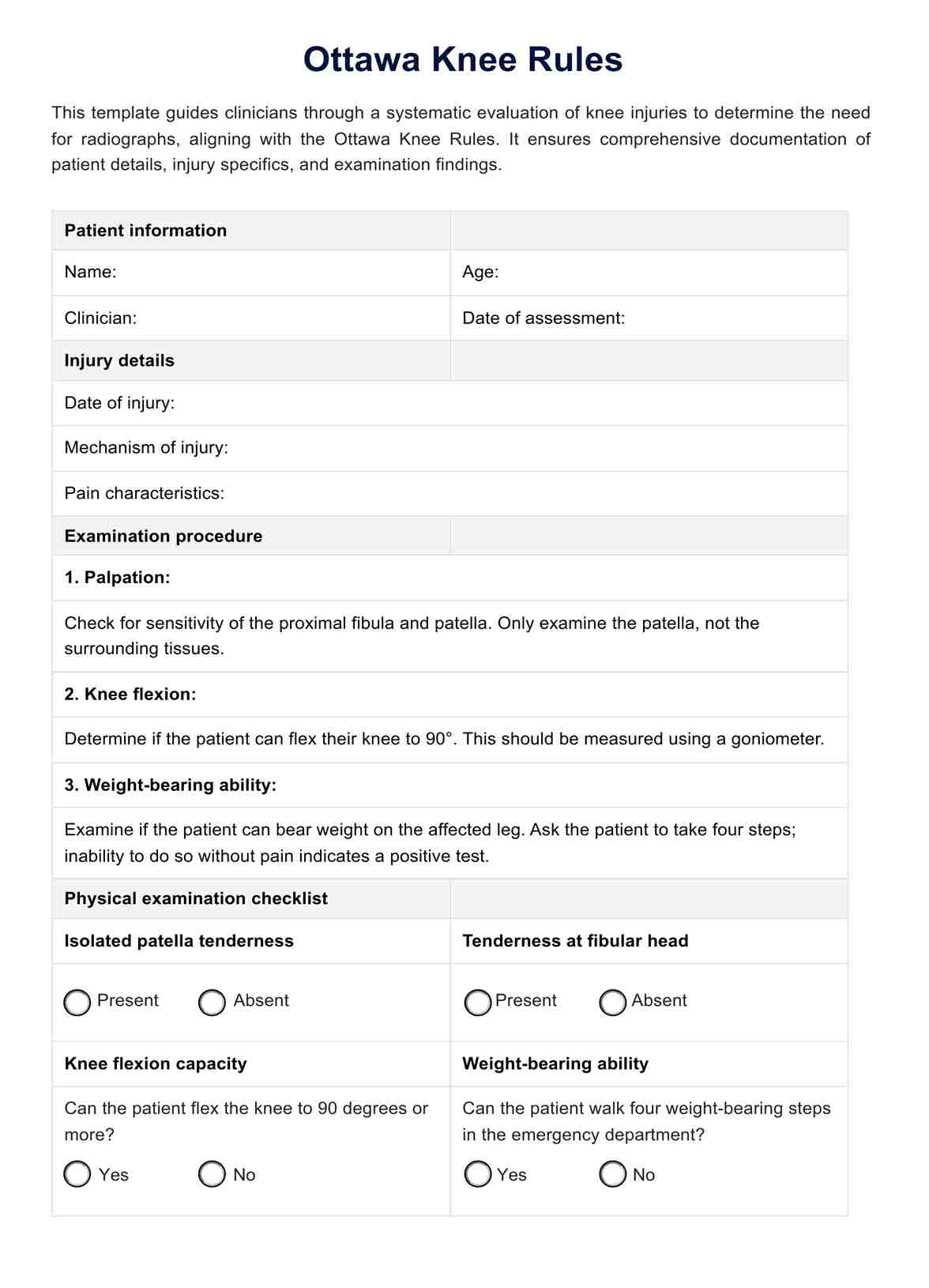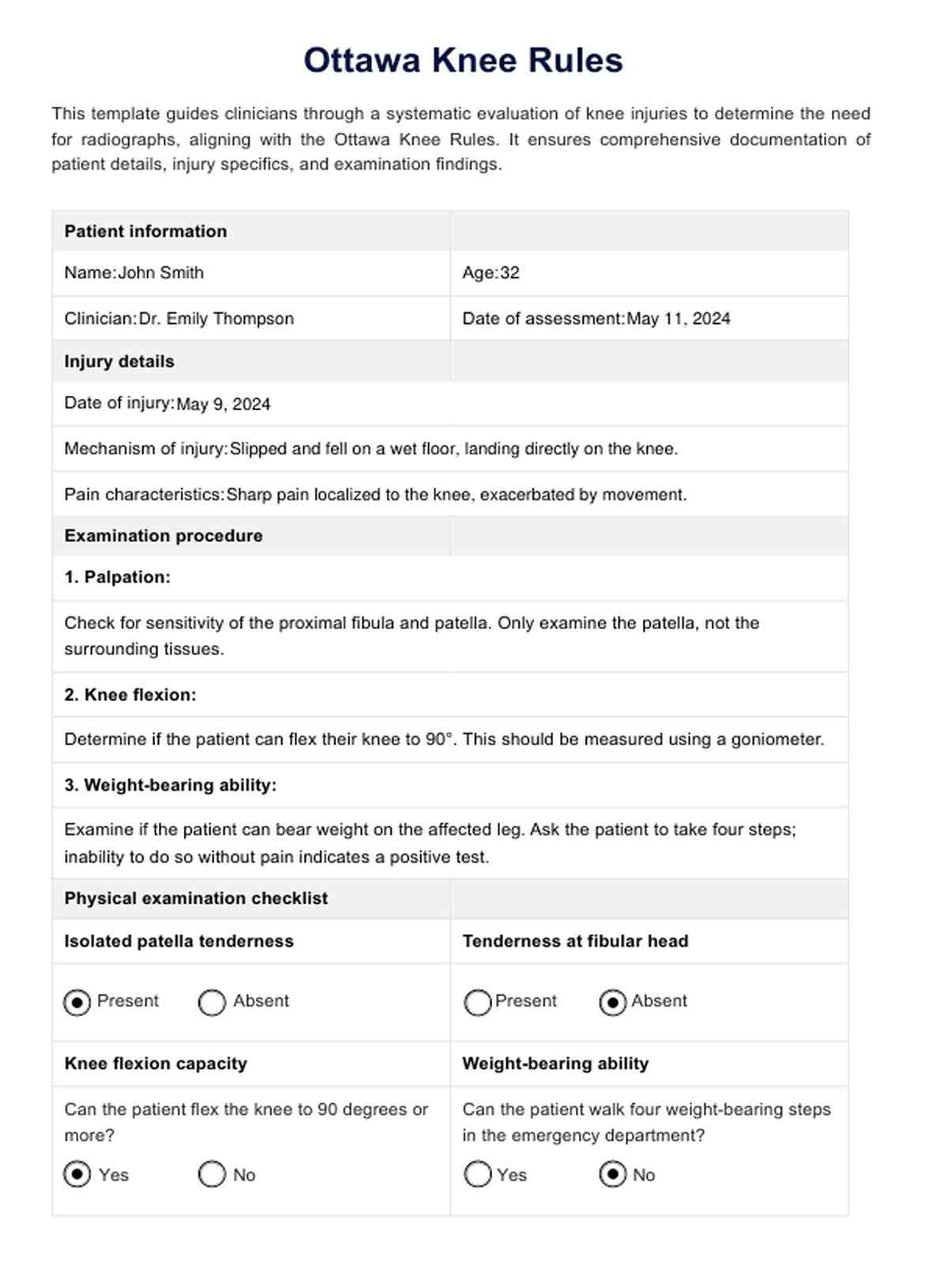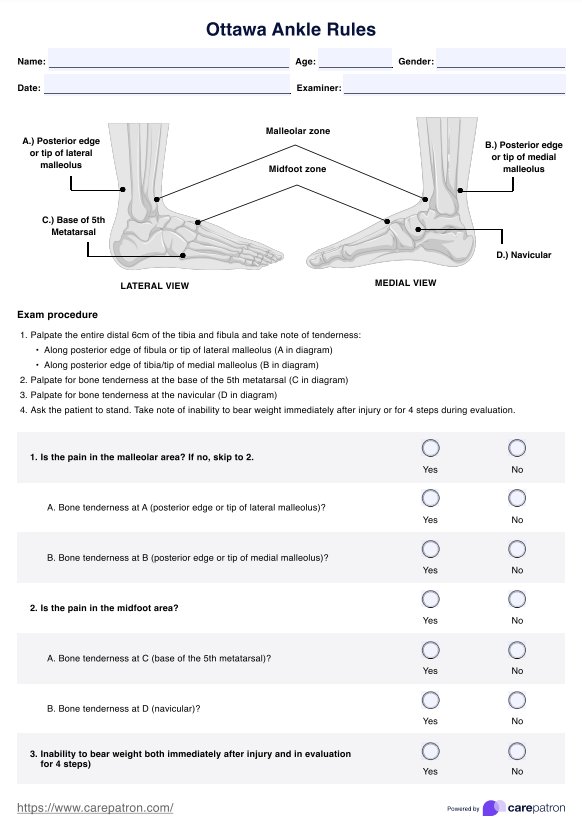Ottawa Knee Rules
Our free template and comprehensive guide will help you discover how the Ottawa Knee Rules can help assess acute knee injuries, reduce unnecessary radiographs, and guide treatment.


What are acute knee injuries?
Acute knee injuries refer to sudden damage to the knee structures caused by external forces like blunt knee trauma. These injuries frequently occur from sports accidents, falls, or direct impacts. They can range from minor soft tissue injuries such as sprains and ligament tears to severe conditions like knee fractures and dislocations. The severity of these injuries often requires a prompt evaluation in the emergency department to ensure proper management.
Ottawa Knee Rules Template
Ottawa Knee Rules Example
What are knee radiographs?
Knee radiographs, commonly known as X-rays, are diagnostic imaging tests used to visualize the knee joint bones. They are essential for identifying fractures or other structural abnormalities, allowing healthcare professionals to distinguish between high-risk knee injuries and minor soft tissue issues. Knee radiography is crucial for emergency medicine and clinical practice, providing accurate information to guide treatment plans.
What are the Ottawa Knee Rules?
The Ottawa Knee Rules are clinical decisions designed to help healthcare professionals decide when knee radiographs are needed in acute knee injury cases. These guidelines minimize unnecessary radiography by identifying specific criteria that indicate high-risk injuries and clinically significant fractures. By accurately identifying patients who need imaging, the Ottawa Knee Rules reduce radiation exposure and optimize resources and use of radiography in emergency departments, improving overall clinical practice and patient care.
Ottawa Knee Rules criteria
The Ottawa Knee Rules suggest that radiography in acute knee is only needed if any of the following criteria are met:
- Age 55 or older
- Tenderness at the head of the fibula
- Isolated tenderness of the patella
- Inability to flex the knee to 90 degrees
- Inability to bear weight both immediately and in the emergency department (four steps; unable to transfer weight twice onto each leg regardless of limping)
How are the Ottawa Knee Rules applied?
The Ottawa Knee Rules are applied through a systematic examination procedure that helps clinicians accurately determine whether a patient with acute knee trauma requires radiographic imaging. This approach ensures efficient use of resources in emergency departments and reduces unnecessary radiation exposure. Here’s a step-by-step guide on how the rules are applied:
Patient interview
Begin by conducting a quick interview with the patient to understand the mechanism of injury and how it occurred. For instance, was the knee injury caused by blunt trauma from a fall, sports incident, or direct blow? Inquire about any history of prior knee injuries or surgeries that could affect the current assessment. Have the patient describe the intensity and nature of their knee pain, noting whether it worsens with specific movements or positions.
Physical examination
A comprehensive physical examination of the knee begins with palpating to locate specific areas of pain or tenderness. This should include checking for isolated tenderness directly over the patella or kneecap and at the fibula's head, just below the knee joint on the lateral side. Both areas are critical for identifying potential injuries or disorders.
Next, assessing the range of motion is crucial for determining the knee's functional capacity. Unlike tenderness, range of motion should be measured using a goniometer to obtain an accurate reading. Position the goniometer at the lateral aspect of the knee, aligning it with the femur and the fibula. Ask the patient to flex and extend the knee. A normal knee should flex to at least 90 degrees without significant pain. Difficulty achieving this range or experiencing pain during the movement is a critical indicator that may require further imaging to identify potential internal damage or structural issues.
Assessment of walking ability
Evaluate the patient’s ability to bear weight and walk unassisted immediately after the injury and within the emergency department. The patient should be able to transfer weight at least twice onto each leg and take four weight-bearing steps without excessive limping or collapsing.
By following this detailed examination procedure using the Ottawa Knee Rules, clinicians can effectively identify high-risk knee injuries that warrant radiographs. This standardized approach helps to differentiate between clinically significant fractures and less severe injuries that can be managed conservatively.
How to use our Ottawa Knee Rules template
Download our template to maximize the benefits of applying the Ottawa Knee Rules appropriately in clinical practice. This template provides a detailed checklist to guide clinicians through each assessment process step.
- Document patient information: Record the patient's name, age, date of assessment, and any relevant medical history that may influence the evaluation.
- Capture injury details: Describe how the injury occurred, whether from blunt trauma, a fall, or a direct blow during sports or other activities. Document the pain's type, location, and severity, especially if flexing the knee worsens it.
- Conduct physical examination: First, check for isolated tenderness at the patella or the fibular head for the physical examination based on the Ottawa Knee Rules. Assess if the knee can flex to at least 90 degrees without significant pain. Lastly, observe the patient's ability to bear weight on four weight-bearing steps.
- Determine radiograph decision: Based on the examination findings, decide if a knee radiograph is required. Record this decision along with the rationale.
- Outline further management steps: Use the template to list immediate interventions, referrals, and planned follow-up or specialist care as needed.
- Finalize with the clinician's signature: The clinician responsible for the assessment should sign the template and include the date.
Our printable Ottawa Knee Rules template ensures a thorough evaluation process and improves diagnostic accuracy while reducing unnecessary imaging.
Reliability of Ottawa Knee Rules
Research supports the high reliability and effectiveness of the Ottawa Knee Rules in clinical practice. According to Bachmann et al. (2004), these rules exhibit high sensitivity, accurately ruling out knee fractures and substantially reducing unnecessary radiographs. Lang (2004) further confirms that the Ottawa Knee Rules can significantly decrease the need for X-rays in patients with acute knee injuries.
Additionally, a systematic review and meta-analysis by Sims et al. (2020) highlight the diagnostic accuracy of these rules, emphasizing their utility in efficiently identifying knee fractures that require radiographic examination. These studies demonstrate the rules' ability to prevent excessive radiation exposure and their high clinical utility in detecting critical injuries.
Acute knee injury treatments
Treatment options for acute knee injuries vary based on the type and severity of the injury but can include:
- Immobilization and bracing
- Pain management and anti-inflammatory medications
- Physical therapy for rehabilitation
- Surgery in cases of severe fractures or ligament damage
References
Bachmann, L. M., Haberzeth, S., Steurer, J., & ter Riet, G. (2004). The accuracy of the Ottawa Knee Rule to rule out knee fractures. Annals of Internal Medicine, 140(2), 121. https://doi.org/10.7326/0003-4819-140-5-200403020-00013
Lang, E. S. (2004). Review: The Ottawa Knee Rule accurately rules out knee fractures and can substantially reduce the need for x-rays in patients with acute knee injuries. Evidence-Based Medicine, 9(5), 151–151. https://doi.org/10.1136/ebm.9.5.151
Sims, J. I., Chau, M. T., & Davies, J. R. (2020). Diagnostic accuracy of the Ottawa Knee Rule in adult acute knee injuries: A systematic review and meta-analysis. European Radiology, 30(8). https://doi.org/10.1007/s00330-020-06804-x
Commonly asked questions
Yes, regular exercise and specific physical therapy can strengthen knee muscles and improve flexibility, significantly reducing the risk of injuries.
Knee braces can stabilize the knee during the healing process, support recovery, and prevent further injury, making them beneficial for patients following certain knee injuries.
Recovery time depends on the type and severity of the injury. Minor injuries like sprains may heal within a few weeks with appropriate rest and physical therapy, while more serious injuries, such as ligament tears or fractures, can require several months of rehabilitation or surgical intervention. Following your healthcare provider's guidance is important for a safe and effective recovery.

.jpg)






































































































